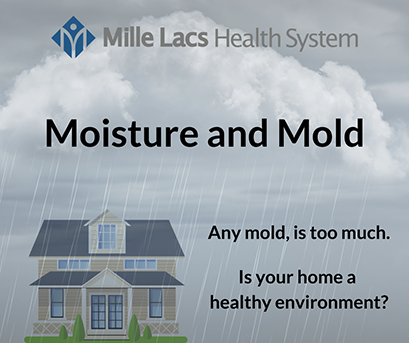Moisture & Mold
July 8, 2024
Lately, Minnesota has had its fair share of rain. Is your home safe from the excess moisture coming in, and is your home set up to properly manage the moisture created inside the home through everyday activities?
Excess moisture can quickly lead to mold. Mold can start to form in as little as 24 – 48 hours. Mold can be black, white, gray, brown, green, or just about any color. The appearance of mold can be described as cottony, velvety, granular, or leathery. It can also appear as a stain or discoloration on a surface. Mold sometimes has an odor often described as “musty” or “earthy.”
Mold is a common allergen, a type of fungus that consists of tiny organisms found almost everywhere. Outdoors, molds play an important role in nature, breaking down dead leaves, plants, and trees. Indoors, mold damages structures and exposes people to a variety of respiratory complications.
Health effects from mold can vary greatly from person to person. Common symptoms can include coughing, runny nose, wheezing, and sore throat. People with asthma, allergies, other underlying health conditions, and the young and old may be affected more greatly.
The Minnesota Department of Health (MDH) does not offer a health-based standard for mold levels in the air. MDH states, “Everyone reacts differently to mold, and there is not enough research available to determine how much mold is ‘safe’.”
If you find mold in your home, the first step is to locate the source of the moisture that’s creating the mold and get it fixed. Common sources of unwanted moisture in homes are: leaky roofs, high humidity from bathrooms/kitchens, leaky pipes, flooding in the basement, or condensation on windows.
Understand that mold may be hidden out of plain sight. Consider locations like the back side of the drywall, wallpaper, or paneling, the top side of ceiling tiles, or the underside of carpets and pads, etc.
To keep indoor surfaces as dry as possible, try to maintain the home's relative humidity between 20-40 percent in the winter, and less than 50-60 percent the rest of the year. A dehumidifier is a common device that can be purchased for the home and used to lower the moisture in the air.
After locating and fixing the source of the excess moisture the next step is the clean up the existing mold. The MDH website details the process to safely remove the mold from hard surfaces, and the optional bleach method that can be used. It also lists the items that cannot be cleaned and need to be disposed of such as carpeting, drywall, etc. Recommendations are also given for the proper safety equipment to wear during clean-up.
It is also worth noting both MDH and the Environmental Protection Agency (EPA) recommend skipping any mold testing. They suggest that any type of mold growing indoors is a potential health hazard and should be dealt with immediately.
